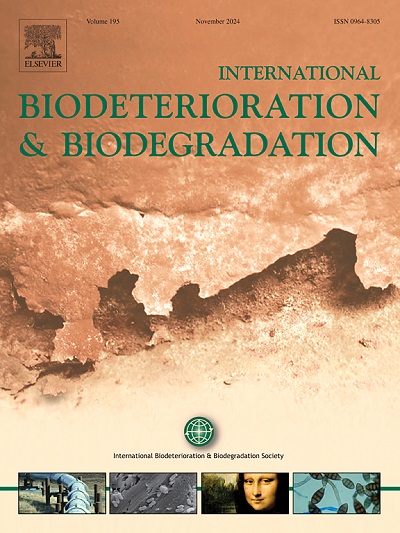ABTS 媒介物增强了嗜酸毛霉 FLU1 和嗜酸塔拉酵母菌 FLU12 的 Laccases 对荧蒽的生物转化作用
IF 4.1
2区 环境科学与生态学
Q2 BIOTECHNOLOGY & APPLIED MICROBIOLOGY
International Biodeterioration & Biodegradation
Pub Date : 2024-10-30
DOI:10.1016/j.ibiod.2024.105946
引用次数: 0
摘要
由于其持久性和毒性,荧蒽对环境构成了严重威胁。研究表明,TlFLU1L(Trichoderma lixii FLU1)和TpFLU12L(Talaromyces pinophilus FLU12)可作为降解荧蒽的生物催化剂。3 U/mL的TlFLU1L和TpFLU12L可在96小时内将残留萤蒽浓度分别降至49.5 ± 8.68 %和61.0 ± 5.66 %,而10 U/mL的TlFLU1L和TpFLU12L可在96小时内将残留萤蒽浓度分别降至19.2 ± 5.95 %和28.7 ± 1.25 %。将 200 μM ABTS(2,2′-氮杂双(3-乙基苯并噻唑啉-6-磺酸)与 3 U/mL酶混合在反应中,可在 48 h 内 100%消除残留的萤石。TlFLU1L 和 TpFLU12L 的 vmax 值几乎相似(分别为 1.35 ± 0.02 和 1.29 ± 0.15 mg/L/h),但 TlFLU1L 的 Km 值低于 TpFLU12L(分别为 119.2 ± 0.02 和 170.8 ± 0.15 mg/L)。ABTS 显着提高了 TlFLU1L 和 TpFLU12L 的 vmax,分别为 7.73 ± 0.23 和 7.97 ± 0.28 mg/L/h,降低了 Km,分别为 54.8 ± 0.27 和 26.6 ± 0.21 mg/L。气相色谱-质谱分析显示,TlFLU1L 产生了代谢物 9-氧代-芴-1-羧酸、9H-芴-9-酮和邻苯二甲酸,而 TpFLU12L 则产生了 9,10-菲二酮和苯-1,2,3-三羧酸。在介质(ABTS)存在的情况下,对 TlFLU1L 和 TpFLU12L 降解产物进行生态毒性和细胞毒性分析,发现它们对海洋细菌(副溶血性弧菌)和 HT22 细胞无毒。因此,这项研究强调了 TlFLU1L 和 TpFLU12L 在环境友好型和高效生物修复受荧蒽污染的环境方面的巨大潜力,特别是在与介质(ABTS)结合使用时。本文章由计算机程序翻译,如有差异,请以英文原文为准。
ABTS mediator enhances biotransformation of fluoranthene by Laccases from Trichoderma lixii FLU1 and Talaromyces pinophilus FLU12
Fluoranthene poses a significant environmental threat due to its persistence and toxicity. The Laccases from Trichoderma lixii FLU1 (TlFLU1L) and Talaromyces pinophilus FLU12 (TpFLU12L) are shown to act as biocatalysts for fluoranthene degradation. 3 U/mL of TlFLU1L and TpFLU12L reduced residual fluoranthene concentration to 49.5 ± 8.68 and 61.0 ± 5.66 %, while 10U/mL to 19.2 ± 5.95 and 28.7 ± 1.25 %, respectively, in 96 h. Mixing 200 μM ABTS (2,2′-azino-bis(3-ethylbenzothiazoline-6-sulfonic acid) with 3 U/mL enzyme in the reaction abolished 100 % residual fluoranthene within 48 h. TlFLU1L and TpFLU12L exhibited almost similar vmax (1.35 ± 0.02 and 1.29 ± 0.15 mg/L/h, respectively), but TlFLU1L showed a lower Km as compared to TpFLU12L (119.2 ± 0.02 and 170.8 ± 0.15 mg/L, respectively). ABTS significantly increased vmax to 7.73 ± 0.23 and 7.97 ± 0.28 mg/L/h, and decreased Km to 54.8 ± 0.27 and 26.6 ± 0.21 mg/L for TlFLU1L and TpFLU12L, respectively. GC-MS analysis revealed that TlFLU1L generated metabolites 9-oxo-fluorene-1-carboxylic acid, 9H-fluoren-9-one, and phthalic acid while TpFLU12L produced 9,10-phenanthrenedione and benzene-1,2,3-tricarboxylic acid. Ecotoxicity and cytotoxicity analysis of TlFLU1L and TpFLU12L degradation products in the presence of the mediator (ABTS) are found to be non-toxic towards marine bacteria (Vibrio parahaemolyticus) and HT22 cells. Thus, the study underscores the promising potential of TlFLU1L and TpFLU12L, particularly in conjunction with mediator (ABTS), for environment friendly and efficient bioremediation of fluoranthene-contaminated environments.
求助全文
通过发布文献求助,成功后即可免费获取论文全文。
去求助
来源期刊
CiteScore
9.60
自引率
10.40%
发文量
107
审稿时长
21 days
期刊介绍:
International Biodeterioration and Biodegradation publishes original research papers and reviews on the biological causes of deterioration or degradation.

 求助内容:
求助内容: 应助结果提醒方式:
应助结果提醒方式:


